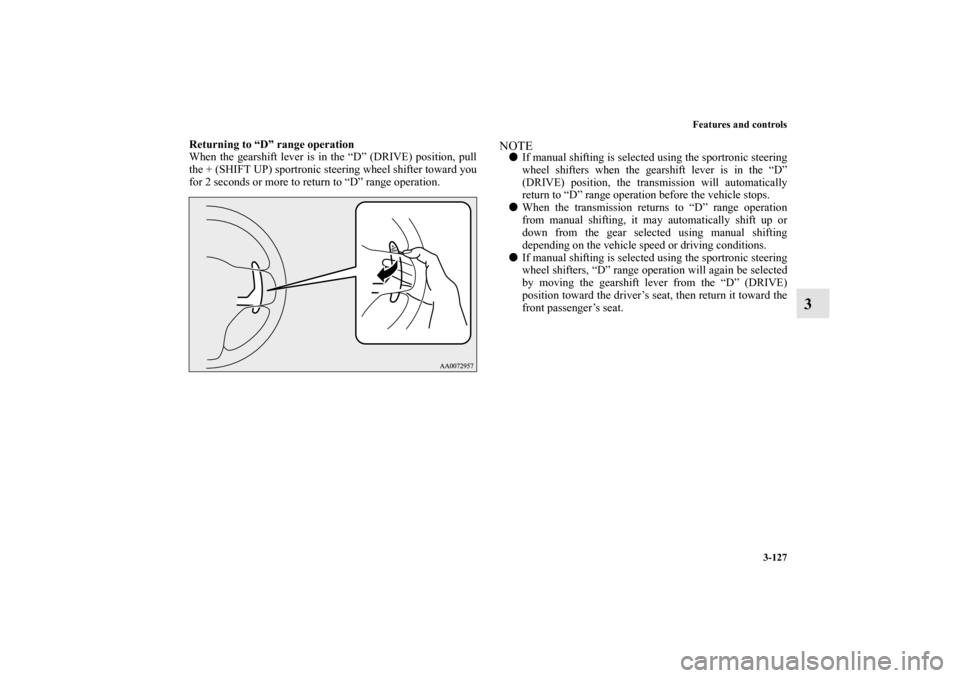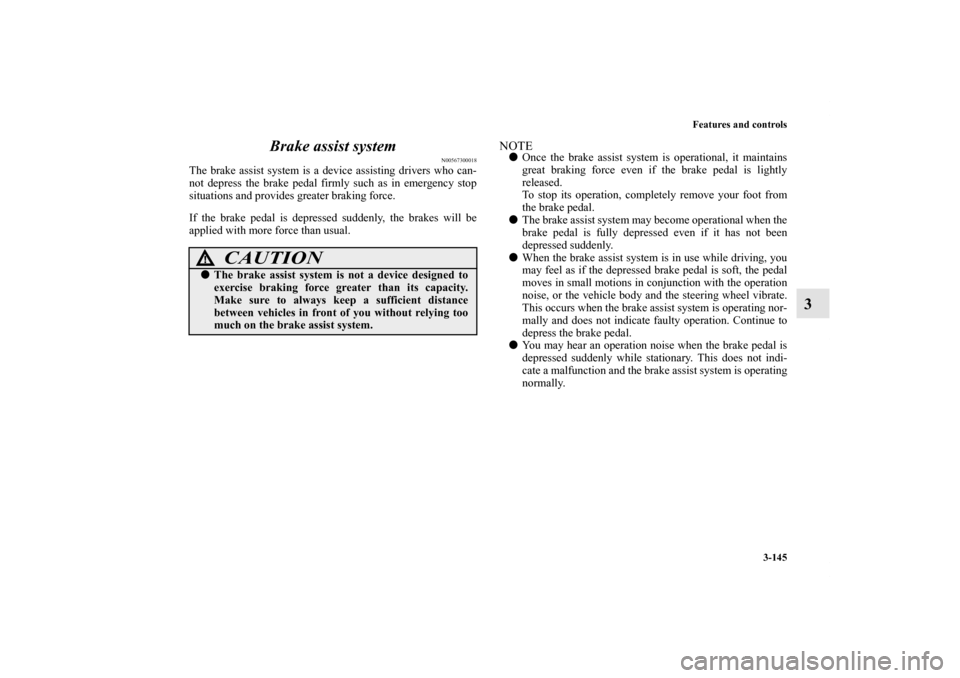Page 218 of 722

Features and controls
3-123
3
NOTE�Only the forward gears 1 to 6 can be selected.
To reverse or park, place the gearshift lever in the “R”
(REVERSE) or “P” (PARK) position.
�During manual shifting, downshifting will be performed
automatically when the vehicle slows down and the trans-
mission will downshift to 1st gear before the vehicle
stops.
�If the gearshift lever or sportronic steering wheel shifters
are operated repeatedly, the transmission will also shift
repeatedly.
�In order to ensure driving performance, upshifting may
not occur depending on the vehicle speed even if the gear-
shift lever or sportronic steering wheel shifters are oper-
ated. In addition, in order to prevent excessive engine
speed, the buzzer sounds and downshifting may not occur
depending on the vehicle speed even if the gearshift lever
or sportronic steering wheel shifters are operated.
�When driving in an aggressive manner involving high
engine rpm, sudden acceleration and/or deceleration, the
Twin Clutch SST could take longer to shift due to higher
fluid temperatures.
CAUTION
!�When manually shifting while the vehicle is being
driven, select the correct shift position to control the
engine speed so that the tachometer indicator does
not enter the red zone.�Sudden engine braking and rapid acceleration can
cause the vehicle to skid. Shift down according to
road conditions and vehicle speed.�If both the left and right sportronic steering wheel
shifters are operated at the same time, the transmis-
sion may not change gears.
BK0138600US.book 123 ページ 2011年7月17日 日曜日 午後2時32分
Page 219 of 722
3-124 Features and controls
3
Shifting using the gearshift lever
N00540600032
Selecting manual shifting
While the vehicle is stopped or being driven, move the gear-
shift lever from the “D” (DRIVE) position in the main shift
gate toward the driver’s seat to select manual shifting.Shifting up and shifting down
Each time the gearshift lever is pulled rearward, the transmis-
sion shifts up 1 gear.
In addition, each time the gearshift lever is pushed forward, the
transmission shifts down 1 gear.
NOTE�After manual shifting is selected using the gearshift lever,
shifting up and down can also be performed using the
sportronic steering wheel shifters.
SHIFT DOWN
SHIFT UP
BK0138600US.book 124 ページ 2011年7月17日 日曜日 午後2時32分
Page 220 of 722
Features and controls
3-125
3
Returning to “D” range operation
Move the gearshift lever toward the front passenger’s seat to
return to automated shifting.NOTE�When the gearshift lever is moved to the “D” (DRIVE)
position from the manual shift gate, it may automatically
select a gear different from the gear selected during man-
ual shifting depending on vehicle speed or driving condi-
tions.
Shifting using the sportronic steering wheel shifters
N00540700033
Selecting manual shifting
While the vehicle is stopped or being driven with the gearshift
lever in the “D” (DRIVE) position, manual shifting can be
selected by pulling one of the sportronic steering wheel shifters
toward you.
- (SHIFT DOWN) + (SHIFT UP)
BK0138600US.book 125 ページ 2011年7月17日 日曜日 午後2時32分
Page 221 of 722
3-126 Features and controls
3
Shifting up
Each time the + (SHIFT UP) sportronic steering wheel shifter
is pulled, the transmission shifts up 1 gear.Shifting down
Each time the - (SHIFT DOWN) sportronic steering wheel
shifter is pulled, the transmission shifts down 1 gear.
NOTE�After manual shifting is selected using the sportronic
steering wheel shifters, shifting up and down can also be
performed using the gearshift lever.
BK0138600US.book 126 ページ 2011年7月17日 日曜日 午後2時32分
Page 222 of 722

Features and controls
3-127
3
Returning to “D” range operation
When the gearshift lever is in the “D” (DRIVE) position, pull
the + (SHIFT UP) sportronic steering wheel shifter toward you
for 2 seconds or more to return to “D” range operation.
NOTE�If manual shifting is selected using the sportronic steering
wheel shifters when the gearshift lever is in the “D”
(DRIVE) position, the transmission will automatically
return to “D” range operation before the vehicle stops.
�When the transmission returns to “D” range operation
from manual shifting, it may automatically shift up or
down from the gear selected using manual shifting
depending on the vehicle speed or driving conditions.
�If manual shifting is selected using the sportronic steering
wheel shifters, “D” range operation will again be selected
by moving the gearshift lever from the “D” (DRIVE)
position toward the driver’s seat, then return it toward the
front passenger’s seat.
BK0138600US.book 127 ページ 2011年7月17日 日曜日 午後2時32分
Page 223 of 722

3-128 Features and controls
3
Manual shift display
N00543000040
In manual shift, the currently selected gear is displayed on the
multi-information display.
Operation of the Twin Clutch SST
N00540800021
through
CAUTION
!�Before selecting a position with the engine running
and the vehicle stationary, fully depress the brake
pedal to prevent the vehicle from creeping.
Do not release the brakes until you are ready to
drive away. The vehicle will begin to move as soon as
the Twin Clutch SST is engaged.�Depress the brake pedal with the right foot.
Using the left foot could cause driver movement
delay in case of an emergency.�To prevent sudden acceleration, never run the
engine at high rpms when shifting from the “P”
(PARK) or “N” (NEUTRAL) position.�Operating the accelerator pedal while the other foot
is resting on the brake pedal will affect braking effi-
ciency, may cause premature wear of brake pads
and may cause engine damage.�Use the gearshift lever in the correct shift position in
accordance with driving conditions.
Never coast downhill backward in the driving shift
position { “D” (DRIVE) or manual shifting} or coast
forward in the “R” (REVERSE) position.
Engine stopping and increased brake pedal and
steering effort could lead to an accident.
BK0138600US.book 128 ページ 2011年7月17日 日曜日 午後2時32分
Page 234 of 722

Features and controls
3-139
3 All-wheel driving operation
N00530600169
For vehicles with full-time 4WDFull-time 4WD vehicles are propelled by engine power distrib-
uted constantly and appropriately to all 4 wheels.
Not only does this ensure enhanced handling on dry, paved
roads but also permits better traction when driving on slippery,
wet or snow-covered roads and when moving out of mud.
These vehicles, however, are not designed for off-road use,
and are unsuitable for driving on bumpy ground that may
cause excessive strain. Full-time 4WD vehicles should be
driven only under the same conditions as are suitable for ordi-
nary front-wheel drive vehicles.For vehicles with electronically controlled 4WD
systemElectronically controlled 4WD system vehicles are propelled
by engine power distributed constantly and appropriately to all
4 wheels.
Not only does this ensure enhanced handling on dry, paved
roads but also permits better traction when driving on slippery,
wet or snow-covered roads and when moving out of mud.
These vehicles, however, are not designed for off-road use,
and are unsuitable for driving on bumpy ground that may
cause excessive strain. Electronically controlled 4WD system
vehicles should be driven only under the same conditions as
are suitable for ordinary front-wheel drive vehicles.
Turning sharp cornersWhen turning a sharp corner in “4WD LOCK” position at low
speed, a slight difference in steering may be experienced simi-
lar to feeling as if the brakes were applied. This is called tight
corner braking and results from each of the four tires being at a
different distance from the corner. The phenomenon is typical
of 4-wheel drive vehicles. If this occurs, either straighten out
the steering wheel, or change to “2WD” or “4WD AUTO”
mode.On snowy or icy roadsSet the drive mode-selector to “4WD AUTO” or “4WD
LOCK” in accordance with the road conditions, and then grad-
ually depress the accelerator pedal for a smooth start.NOTE�The use of snow tires is recommended.
�Maintain a safe distance between vehicles, avoid sudden
braking, and use engine braking (downshifting).
CAUTION
!�Avoid sudden braking, sudden acceleration, and
sharp turning. Skidding occurs and control of the
vehicle could be lost.
BK0138600US.book 139 ページ 2011年7月17日 日曜日 午後2時32分
Page 240 of 722

Features and controls
3-145
3 Brake assist system
N00567300018
The brake assist system is a device assisting drivers who can-
not depress the brake pedal firmly such as in emergency stop
situations and provides greater braking force.
If the brake pedal is depressed suddenly, the brakes will be
applied with more force than usual.
NOTE�Once the brake assist system is operational, it maintains
great braking force even if the brake pedal is lightly
released.
To stop its operation, completely remove your foot from
the brake pedal.
�The brake assist system may become operational when the
brake pedal is fully depressed even if it has not been
depressed suddenly.
�When the brake assist system is in use while driving, you
may feel as if the depressed brake pedal is soft, the pedal
moves in small motions in conjunction with the operation
noise, or the vehicle body and the steering wheel vibrate.
This occurs when the brake assist system is operating nor-
mally and does not indicate faulty operation. Continue to
depress the brake pedal.
�You may hear an operation noise when the brake pedal is
depressed suddenly while stationary. This does not indi-
cate a malfunction and the brake assist system is operating
normally.
CAUTION
!�The brake assist system is not a device designed to
exercise braking force greater than its capacity.
Make sure to always keep a sufficient distance
between vehicles in front of you without relying too
much on the brake assist system.
BK0138600US.book 145 ページ 2011年7月17日 日曜日 午後2時32分